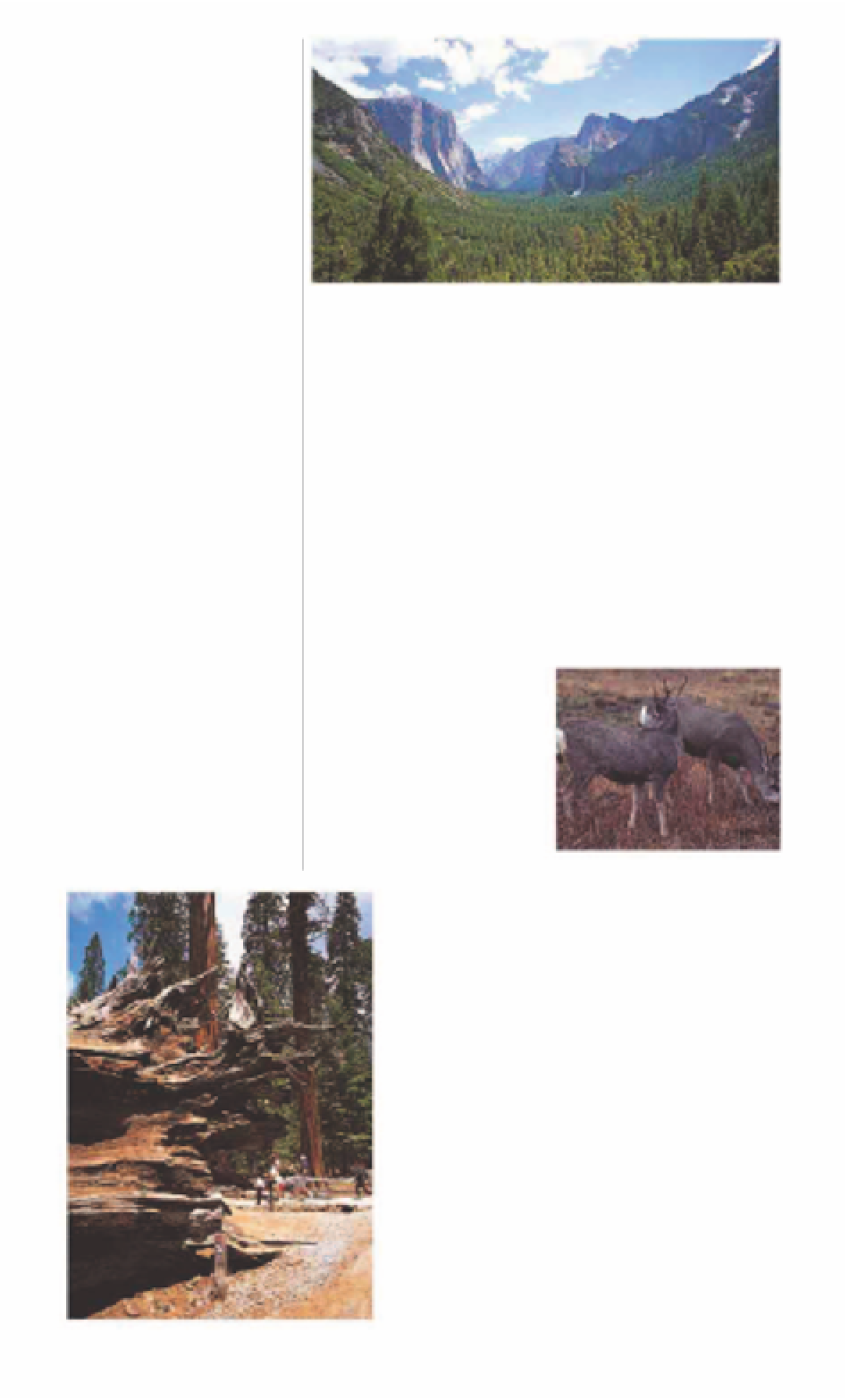Travel Reference
In-Depth Information
}
Glacier Point
Glacier Point Rd.
Open
May-Oct: daily.
The great Yosemite panorama
can be experienced from Glacier
Point, which rests on a rocky
ledge 3,215 ft (980 m) above the
valley floor. Most of the
waterfalls and other features of
Yosemite Valley are visible from
here, but the dominant feature
is Half Dome. The panorama
also includes much of the
surrounding landscape, a
beautiful area of alpine peaks
and meadows.
Glacier Point can be reached
only during the summer. The
road is blocked by snow during
winter at Badger Pass, which
was developed in 1935 as
California's first commercial ski
resort. Another summer route is
the Four-Mile Trail, which begins
at the western side of the valley.
Summer bus services also allow
hikers to ride up to Glacier Point
then hike down to the valley.
Tunnel View, looking across Yosemite Valley
through the grove, and open-
air trams make a 5-mile (8-km)
circuit along roads constructed
during the early years of
Yosemite tourism.
}
Tuolumne Meadows
Hwy 120, Tioga Rd.
Open
Jun-Sep: daily.
In summer, when the snows
have melted and the wildflowers
are in full bloom, the best place
to experience the striking beauty
of the Yosemite landscape are
these sub-alpine meadows
along the Tuolumne River.
Located 55 miles (88 km) from
Yosemite valley via Tioga Pass
Road, Tuolumne Meadows are
also a base for hikers setting off
to explore the area's many
granite peaks and trails.
}
Tunnel View
Hwy 41 overlooking Yosemite Valley.
Open
daily.
One of the most photographed
views of Yosemite can be seen
from this lookout on Hwy 41 at
the western end of the valley.
Despite the name, which is
taken from the highway tunnel
that leads to Glacier Point Road,
the view is incredible, with El
Capitán on the left, Bridalveil
Fall on the right and Half Dome
at the center.
}
Mariposa Grove
Visitors' Center
Hwy 41, South
Entrance.
Open
mid-May-Oct: daily.
At the southern end of Yose-
mite, this beautiful grove was
one of the main reasons the
park was established. More than
500 giant sequoia trees can be
seen here, some of which are
more than 3,000 years old, 250 ft
(75 m) tall and more than 30 ft
(9 m) in diameter at their base.
A series of hiking trails winds
}
El Capitán
Northwestern end of Yosemite Valley.
Open
daily.
Standing guard at the western
entrance to Yosemite Valley, the
granite wall of El Capitán rises
more than 4,500 ft
(1,370 m) above the
valley floor. The
world's largest
exposed rock, El
Capitán is a magnet
to rock-climbers, who
spend days on its
sheer face to reach
the top. The less
adventurous
congregate in the
meadow below,
watching the rock-
climbers through
binoculars.
Named by US
soldiers, who in 1851
were the first white
Americans to visit the
valley, El Capitán is
the Spanish phrase
for “captain.”
A pair of mule deer roaming Yosemite's
meadows
P
Ahwahnee Hotel
Yosemite Valley.
Te l
(209) 372-1407.
Open
daily.
A building that comes close to
Yosemite's natural beauty is the
Ahwahnee Hotel, built in 1927 at
a cost of $1.5 million. It was
designed by Gilbert Stanley
Underwood, who used giant
granite boulders and massive
wood timbers to create a rustic
elegance in tune with its
surroundings. The interior of the
Ahwahnee Hotel also emulates
the natural setting, decorated in
a Native American style.
Examples of Native American arts
and crafts are on display in the
lobbies. The hotel is also noted
for its high-quality restaurant, the
Ahwahnee Dining Room.
Giant sequoia trees in Mariposa Grove

































